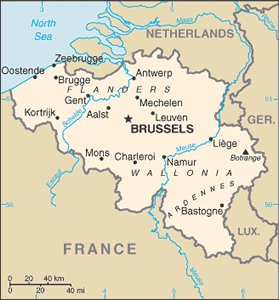The Geography of Belgium
The Geography of Belgium
Belgian Geography
Location: Western Europe, bordering the North Sea, between France and the Netherlands
Geographic coordinates: 50 50 N, 4 00 E
Map references: Europe
Area: total: 30,528 sq km land: 30,278 sq km water: 250 sq km
Area - comparative: about the size of Maryland
Land boundaries: total: 1,385 km border countries: France 620 km, Germany 167 km, Luxembourg 148 km, Netherlands 450 km
Coastline: 66.5 km
Maritime claims: territorial sea: 12 nm contiguous zone: 24 nm exclusive economic zone: geographic coordinates define outer limit continental shelf: median line with neighbors
Climate: temperate; mild winters, cool summers; rainy, humid, cloudy
Terrain: flat coastal plains in northwest, central rolling hills, rugged mountains of Ardennes Forest in southeast
Elevation extremes: lowest point: North Sea 0 m highest point: Signal de Botrange 694 m
Natural resources: construction materials, silica sand, carbonates
Land use: arable land: 27.42% permanent crops: 0.69% other: 71.89% note: includes Luxembourg (2005)
Irrigated land: 400 sq km (2003)
Natural hazards: flooding is a threat along rivers and in areas of reclaimed coastal land, protected from the sea by concrete dikes
Environment - current issues: the environment is exposed to intense pressures from human activities: urbanization, dense transportation network, industry, extensive animal breeding and crop cultivation; air and water pollution also have repercussions for neighboring countries; uncertainties regarding federal and regional responsibilities (now resolved) had slowed progress in tackling environmental challenges
Environment - international agreements: party to: Air Pollution, Air Pollution-Nitrogen Oxides, Air Pollution-Persistent Organic Pollutants, Air Pollution-Sulfur 85, Air Pollution-Sulfur 94, Air Pollution-Volatile Organic Compounds, Antarctic-Environmental Protocol, Antarctic-Marine Living Resources, Antarctic Seals, Antarctic Treaty, Biodiversity, Climate Change, Climate Change-Kyoto Protocol, Desertification, Endangered Species, Environmental Modification, Hazardous Wastes, Law of the Sea, Marine Dumping, Marine Life Conservation, Ozone Layer Protection, Ship Pollution, Tropical Timber 83, Tropical Timber 94, Wetlands, Whaling signed, but not ratified: none of the selected agreements
Geography - note: crossroads of Western Europe; most West European capitals within 1,000 km of Brussels, the seat of both the European Union and NATO


